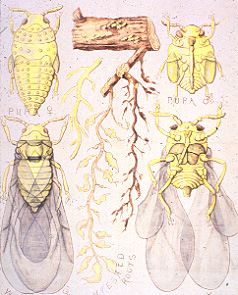

The foliar form overwinters as eggs on canes. Eggs hatch when the leaves have emerged in the spring. Nymphs move to upper leaf surfaces and begin feeding. Their feeding induces the formation of galls on the leaves (Fig. 2). After about 15 days, the adult stage is reached within the galls. Young are produced parthenogenetically (no males present) and 6-7 generations occur on the leaves. Crawlers (Plate 4) will move from older leaves to leaves at shoot tips. Occasionally, ome individuals may drop to the ground and move to the roots. In the fall, females lay from 3-8 eggs that result in insects of both sexes, including winged forms. These mate, and females lay a single egg that overwinters.
In the root form, phylloxera overwinter on the surfaces of root galls. When roots start growing in the spring, these asexual insects lay eggs and produce several generations. Fungal infection in roots are more severe in the presence of phylloxera.
This pest illustrates one of the classic cases of
host plant resistance. Native American grape rootstocks are resistant
to
the grape phylloxera, while European varieties are susceptible. When
the
insect was introduced into Europe in about 1860, the French wine
industry
was nearly destroyed. However, the vines were saved by grafting them
onto
imported American rootstocks. Resistant rootstocks are still important
in preventing damage by the grape phylloxera. Nymphal establishment and
adult reproductive rates are lower on resistant rootstocks than on
susceptible
types. In the early 1980's, a biotype appeared in California with the
ability
to colonize some resistant rootstocks. Research in that state has been
performed on
remote
sensing of phylloxera infestations. See additional
phylloxera
comments, and sampling
vineyards from California,
and Oregon photo.
See
a
student
report
on grape phylloxera prepared for "Arthropod Management in Fruit Crops".